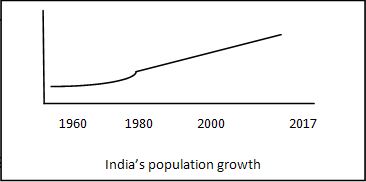Feeding India's Billion plus Population , the Roadmap Ahead.
India is a huge landmass with huge population. The chief issue of our nation is population explosion and the issue severe than it is the management of it. In last few decades India’s population has increased rapidly with a current position of 133.92 crore people according to 2017 estimate. According to World Bank report within coming 30 years we are going to exceed China in population.
 Roti (food), Kapada(dress) and Makan (house) are minimum essentials for every human being but supply of all these essentials matters to every citizen is very tough as we are over burdened with our population. Population explosion is not only a burden but it can also be treated as human resource for development of our society but before all, we need to arrange food for all and for that we need a strategic roadmap.
Roti (food), Kapada(dress) and Makan (house) are minimum essentials for every human being but supply of all these essentials matters to every citizen is very tough as we are over burdened with our population. Population explosion is not only a burden but it can also be treated as human resource for development of our society but before all, we need to arrange food for all and for that we need a strategic roadmap.
Roadmap taken by government
Both central and state governments have taken initiative to ensure food for every citizen under National Food Security Act (NFSA) as food is one of the fundamental rights of every human being. Subsidized food items like rice, wheat, sugar are provided to the enlisted people. Government has also stressed importance on food fortification to ensure quality of food items to maintain the nutrition level in every human being. In past several years government has increased its allocation of funds in food subsidies. In 2018 government allocated Rs. 1.69 lakh crore for food subsidies which has been increased to Rs. 2.96 lakh crore in 2019.
Besides government has also stressed upon the well being of our ‘annadatas’ (farmers). For the improvement of the condition of our farmers government has introduced several policies/schemes like PM – AASHA, PM – KISAN, schemes by various state governments like KALIA by Odisha, KRISHAK BANDHU (farmers’ friend) by West Bengal, Kaleswaram Lift Irrigation Project by Telangana etc. Government provides subsidies to farmers in various forms like seed subsides, electricity subsides, fertilizer subsidies, transportation subsidies etc. Government has also announced minimum support price for several crop items and government e-marketplace has also been formed. Insurance schemes for farmers and farming lands has also been introduced to the betterment of our farmers as they produce food items as good farmers are needed for good foods.
Public Distribution System (PDS) has also been strengthened for better circulation of food items. Number and amount of buffer stock have also been increased positively. Besides to ensure the nutrition level in children government is maintaining mid day meal system from ICDS level to secondary level and quality of food items and nutrition level is also mentioned there. As a result the number of stunted children is decreasing gradually.
Shortcomings in the map
Though government has taken several steps to feed India’s billion plus people but still there lies some loopholes in the strategies.
- Government policies/schemes are fine but these often lack proper attention or scrutiny of the authority.
- Illiteracy is another severe issue. Nearly 30% of our rural people are still illiterate, they are not aware of the government schemes and they are often deprived of proper benefits.
- Economic growth is another issue here. As our economy is not growing satisfactorily, continuance of the existing benefits is unsure.
- Corruption is another issue. Sometimes subsidized food grains are sold in black market. There is no strategic policy to resist this.
Way forward
To tackle this issue we need more comprehensive strategic policies.
- Population control should be our first concern. Government should introduce any stringent policy to resist population explosion so that resources can be used sustainably.
- Government should focus more on economic growth and job creation because when people will have money they will themselves afford food.
- Inflation on food items could be disastrous. So a strict policy is needed to control food inflation at any circumstance.
- Focus may be on the cultivation of Bt crops with proper norms.
- Stringent policies regarding dry food items and dairy products are needed.
- Focus should also be on horticulture, pisciculture etc.
Besides all these individually we have to be aware of our present scenario. Our individual little help may add aid to the government effort. We should start from anywhere keeping it in mind that “if you cannot feed hundred, then feed one.”
- Shuvajyoti Dutta

